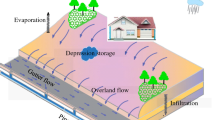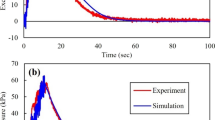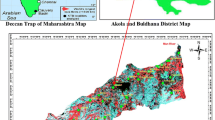Abstract
Water inrush accident into tunnel has become a bottleneck problem restricting the construction of deep-buried long tunnels, and the effect of intersecting faults on water inflow into tunnel is more complicated. Based on in-situ water pressure test data, the change law of the seepage characteristics in fault zone is analyzed, and an improved Darcy–Brinkman seepage model based on the theory of three-district zoning of faults is established. By assuming that the permeability coefficient conforms to the superposition principle, the underground seepage numerical model of intersecting faults that with perpendicular directions to tunnel is established. Then five calculation conditions are analyzed when the tunnel excavation axis is located at different relative height of the fault intersection center, so as to obtain the effect of the relative vertical location of the tunnel to the fault intersection center on the water pressure field, the seepage velocity field and the water inflow into tunnel. The results show that water inflow into tunnel crossing intersecting faults has litter relationship with the upper or lower position between the fault intersection center and the tunnel, but mainly depends on the relative height between them. The smaller the relative height, the smaller the water pressure, the greater the water inflow. Compared with the theoretical formula method and the stochastic mathematical method, the numerical simulation method can reflect the gradual process of water inrush while encountering intersecting faults in excavation and the change law of water inflow in different space and time under specific geological conditions, which is most consistent with the in-situ water inflow monitoring data.















Similar content being viewed by others
Data Availability
The data used to support the findings of this study are available from the corresponding author upon request.
References
Abdollahi MS, Najafi M, Bafghi AY, Marji MF (2019) A 3D numerical model to determine suitable reinforcement strategies for passing TBM through a fault zone, a case study: Safaroud water transmission tunnel, Iran. Tunnell Undergr Space Technol 88:186–199
Li SC, Xu ZH, Huang X et al (2018) Classification, geological identification, hazard mode and typical case studies of hazard-causing structures for water and mud inrush in tunnels. Chin J Rock Mech Eng 37(5):1041–1068
Li YY, Zhang SC, Xu YQ et al (2020) Experimental study on fracture and gushing mechanism of surrounding rock of fault caused by tunnel excavation disturbance. Rock Soil Mech 41(2):1–8
Luo XW, He FL (2014) A study of geological structures inclined to disaster and models of water burst in deep-buried long tunnels. Mod Tunnell Technol 1(51):21–25
Wang XT, Li SC, Xu ZH et al (2019a) An interval risk assessment method and management of water inflow and inrush in course of karst tunnel excavation. Tunn Undergr Space Technol 92:103033
Wang XT, Li SC, Xu ZH et al (2019b) Risk assessment of water inrush in karst tunnels excavation based on normal cloud model. Bull Eng Geol Environ 78(5):3783–3798
Wang XT, Li SC, Xu ZH et al (2019c) Analysis of factors influencing floor water inrush in coal mines: a nonlinear fuzzy interval assessment method. Mine Water Environ 38(1):81–92
Wu H, Yang XH, Chen XY (2017) Model test on water gushing characteristics of tunnel in water rich fault. J chang’an Univ (nat Sci Ed) 37(5):73–80
Wu J, Wu L, Zhao CL (2020) Prediction of water inflow into a tunnel based on three-district zoning of faults. Earth Environ Sci 570(2):022070
Wu J, Wu L, Sun M et al (2021) Analysis and research on blasting network delay of deep-buried diversion tunnel crossing fault zone based on EP-CEEMDAN-INHT. Geotechn Geol Eng 2021:1–10
Xu ZH, Wang WY, Lin P et al (2021a) Hard-rock TBM jamming subject to adverse geological conditions: Influencing factor, hazard mode and a case study of Gaoligongshan Tunnel. Tunn Undergr Space Technol 108:103683
Xu ZH, Liu FM, Lin P et al (2021b) Non-destructive, in-situ, fast identification of adverse geology in tunnels based on anomalies analysis of element content. Tunn Undergr Space Technol 118:104146
Xu ZH, Lin P, Xing HL et al (2021c) Hydro-mechanical coupling response behaviors in tunnel subjected to a water-filled karst cave. Rock Mech Rock Eng 54(8):3737–3756
Xu ZH, Pan DD, Lin P et al (2021d) Numerical investigation of flow control technology for grouting and blocking of flowing water in karst conduits. Int J Numer Anal Meth Geomech 45(12):1712–1738
Zareia HR, Uromeihya A, Sharifzadeh M (2011) Evaluation of high local groundwater inflow to a rock tunnel by characterization of geological features. Tunn Undergr Space Technol 26(2):364–373
Zheng Z, Liu R, Zhang Q (2019) Numerical simulation and risk assessment of water inrush in a fault zone that contains a soft infill. Mine Water Environ 38(3):667–675
Zhu BB, Dong DJ, Wu L (2017) On the prediction of water inflow in deep buried diversion tunnel through water-rich fault. J Railw Sci Eng 14(11):2407–2417
Funding
This work is supported by the National Natural Science Foundation of China (41672260 and 41907259) and the scientific research program of Hubei Provincial Education Department (Q20202701).
Author information
Authors and Affiliations
Corresponding author
Ethics declarations
Conflict of interest
No potential conflict of interest was reported by the authors.
Additional information
Publisher's Note
Springer Nature remains neutral with regard to jurisdictional claims in published maps and institutional affiliations.
Rights and permissions
About this article
Cite this article
Wu, J., Wu, L., Lu, Yn. et al. Prediction of Water Inflow into Tunnel Crossing Intersecting Faults Based on IDB Seepage Model. Geotech Geol Eng 40, 4041–4056 (2022). https://doi.org/10.1007/s10706-022-02137-2
Received:
Accepted:
Published:
Issue Date:
DOI: https://doi.org/10.1007/s10706-022-02137-2




